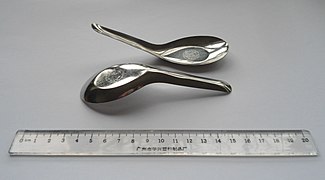Chinese spoon
| Chinese spoon | |||||||
|---|---|---|---|---|---|---|---|
 Chinese porcelain spoon | |||||||
| Chinese name | |||||||
| Traditional Chinese | 調羹 | ||||||
| Simplified Chinese | 调羹 | ||||||
| Literal meaning | for adjusting seasoning of geng | ||||||
| |||||||
| Alternative Chinese name | |||||||
| Traditional Chinese | 湯匙 | ||||||
| Simplified Chinese | 汤匙 | ||||||
| Literal meaning | soup spoon | ||||||
| |||||||
| Second alternative Chinese name | |||||||
| Chinese | 勺子 | ||||||
| Literal meaning | ladle | ||||||
| |||||||
| Japanese name | |||||||
| Kanji | 散蓮華 | ||||||
| |||||||
The Chinese spoon or Chinese soup spoon is a type of spoon with a short, thick handle extending directly from a deep, flat bowl.[1] It is a regular utensil in Chinese cuisine used for liquids, especially soups, or loose solid food. Most are made from ceramics.[1] Although normally used as an eating utensil, larger versions of the Chinese spoon are also used as serving spoons or ladles. It can be stacked on top of one another for storage.
Spoons were used as early as the Shang dynasty of the 2nd millennium B.C., both as a cooking tool and in eating, and were more common than chopsticks until perhaps the 10th century A.D.
Chinese spoons typically have higher sides and can hold more than the western soup spoon.[1] These spoons are used throughout Asia.
History
[edit]The spoon (匕, bǐ) was known as early as the Shang dynasty. The earliest found were made of bone, but bronze specimens are also found that have sharp points, suggesting they were used for cutting. These could be more than a foot long. During the Spring and Autumn period a rounder form appeared, and lacquer spoons are also found, becoming popular in the Han dynasty.[2]
In ancient China the spoon was more common than chopsticks, which were used in cooking. The spoon was more useful for eating because the most common food grain in North China was millet, which was made into a congee, or gruel. The spoon was better fitted for eating its soupy texture in an elegant way.[3]
The spoon was gradually undermined as the most common eating utensil starting in the Han, roughly the 1st century A.D., when wheat began to be more widely grown. Milling technology became sophisticated enough to produce flour for noodles and dumplings. Since these were more easily lifted with chopsticks, the spoon lost its prominence by about the Song dynasty, or 10th century. Early-ripening rice, which was introduced from Vietnam at this time, was even easier to eat with chopsticks, since it cooked into clumps.[3]
The first compasses were created in China in the Han or soon after the Han by using a spoon shaped lodestone which rotated on a bronze plate (see image below).[4]
In the system of classification used in the Kangxi Dictionary, compiled in the 18th century, Radical 21 (classifier #21) is "spoon."
Spoons in history
[edit]
-
Han dynasty spoon compass
-
Song dynasty silver chopsticks, cup, and spoon
Modern spoons
[edit]-
Stainless steel spoons
-
Porcelain spoons
-
Spoon on a spoon rest
See also
[edit]References
[edit]- ^ a b c Newman, Jacqueline M. (2004). Food culture in China. Westport, Conn.: Greenwood Press. p. 107. ISBN 978-0-313-32581-6.
- ^ H.T. Huang (Huang Xingzong), Fermentations and Food Science Part 5 of Biology and Biological Technology, Volume 6 of Joseph Needham, ed., Science and Civilisation in China, (Cambridge: Cambridge University Press, 2000) 106-107
- ^ a b Wang, Q. Edward (12 March 2015), "Surprising Facts About the History of Chopsticks", Fifteen eightyfour: Academic Perspectives from Cambridge University Press, Cambridge University Press
- ^ Needham, Joseph (1986) Science and civilisation in China, Vol. 4: "Physics and physical technology", Pt. 1: "Physics" (Cambridge University Press (1962), ISBN 0-521-05802-3 p. 563





